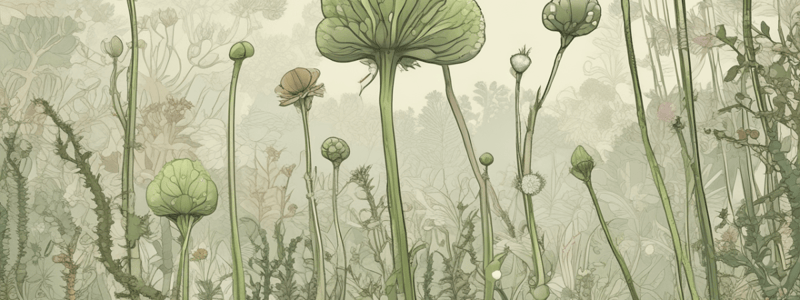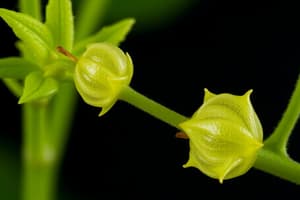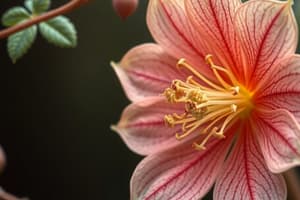Podcast
Questions and Answers
What is the ecological importance of mosses?
What is the ecological importance of mosses?
- Serve as major primary producers in tropical regions
- Harvested for fuel in dry desert environments
- Thrive in extreme environments like mountain tops and deserts (correct)
- Act as pioneer species in nutrient-rich soils
Which plant is often referred to as 'peat moss' and is important for its role in bogs?
Which plant is often referred to as 'peat moss' and is important for its role in bogs?
- Club Moss
- Ferns
- Sphagnum (correct)
- Polytrichum commune
What is a characteristic of seedless vascular plants (SVP) mentioned in the text?
What is a characteristic of seedless vascular plants (SVP) mentioned in the text?
- Presence of a vascular system for water and nutrient transport (correct)
- Dominance of haploid gametophyte in the life cycle
- Lack of vascular tissue for nutrient transport
- Reliance on gametophyte for nutrition
Which part of the moss plant grows up from the female gametophyte for spore dispersal?
Which part of the moss plant grows up from the female gametophyte for spore dispersal?
What is one role of Sphagnum, or 'peat moss,' in wetlands?
What is one role of Sphagnum, or 'peat moss,' in wetlands?
What distinguishes seedless vascular plants from non-vascular plants like mosses?
What distinguishes seedless vascular plants from non-vascular plants like mosses?
Which type of plant serves as primary producers in cold or high-altitude regions according to the text?
Which type of plant serves as primary producers in cold or high-altitude regions according to the text?
What structure helps in the absorption of water and minerals in plants?
What structure helps in the absorption of water and minerals in plants?
Which plant structure is responsible for protecting the egg during fertilization?
Which plant structure is responsible for protecting the egg during fertilization?
What is the main purpose of sporopollenin in plants?
What is the main purpose of sporopollenin in plants?
In plants, what is the role of apical meristems?
In plants, what is the role of apical meristems?
Which chemicals in plants deter, repel, or poison competitors, herbivores, and parasites?
Which chemicals in plants deter, repel, or poison competitors, herbivores, and parasites?
What do gametangia protect within the plant structure?
What do gametangia protect within the plant structure?
Which feature of plants is responsible for preventing desiccation while allowing gas exchange?
Which feature of plants is responsible for preventing desiccation while allowing gas exchange?
What is the main difference between microphylls and megaphylls?
What is the main difference between microphylls and megaphylls?
Which type of leaves exhibit greater photosynthetic productivity, according to the text?
Which type of leaves exhibit greater photosynthetic productivity, according to the text?
What structure are lycophyte sporophylls modified into?
What structure are lycophyte sporophylls modified into?
Which group exhibits homosporous spore production?
Which group exhibits homosporous spore production?
What is the main difference between heterosporous and homosporous spore production?
What is the main difference between heterosporous and homosporous spore production?
Which plant group belongs to the phylum Monilophyta?
Which plant group belongs to the phylum Monilophyta?
In heterosporous spore production, where is the megaspore produced?
In heterosporous spore production, where is the megaspore produced?
What is the defining characteristic of whisk ferns (Psilotum)?
What is the defining characteristic of whisk ferns (Psilotum)?
Where does photosynthesis occur in horsetails (Equisetum)?
Where does photosynthesis occur in horsetails (Equisetum)?
What is the term used to describe plants that grow on the surface of another plant?
What is the term used to describe plants that grow on the surface of another plant?
Which group of plants is considered an important biological indicator of environmental pollution?
Which group of plants is considered an important biological indicator of environmental pollution?
What feature of a fern is known as a 'fiddlehead'?
What feature of a fern is known as a 'fiddlehead'?
Which plant group accelerates the formation of topsoil?
Which plant group accelerates the formation of topsoil?
What is the primary function of peat moss (Sphagnum) in the ecosystem?
What is the primary function of peat moss (Sphagnum) in the ecosystem?
Which term refers to the nonvascular plants collectively?
Which term refers to the nonvascular plants collectively?
Which structure in bryophytes is responsible for attachment but is not a true root?
Which structure in bryophytes is responsible for attachment but is not a true root?
Which phylum of bryophytes is commonly known as Hornworts?
Which phylum of bryophytes is commonly known as Hornworts?
In bryophytes, which generation is dominant and produces eggs and flagellated sperm?
In bryophytes, which generation is dominant and produces eggs and flagellated sperm?
Which part of a liverwort gametophyte resembles miniature trees in some species?
Which part of a liverwort gametophyte resembles miniature trees in some species?
What is the common name for hornworts, based on the shape of their sporophyte?
What is the common name for hornworts, based on the shape of their sporophyte?
Which type of liverwort has sporophytes that are reduced or very small?
Which type of liverwort has sporophytes that are reduced or very small?
Flashcards are hidden until you start studying
Study Notes
From Water to Land
- Multicellular sporangium produces walled haploid spores that disperse through air, protected by sporopollenin.
- Gametophyte and sporophyte generations alternate, with gametophyte producing gametes and sporophyte producing spores.
Evolution of Land Plants
- Apical meristems allow for continuous growth of roots and shoots towards resources such as light, CO2, water, and minerals.
- Waxy cuticle prevents desiccation, but pores are needed to allow CO2/O2 exchange; controllable stomata regulate gas exchange in most plants.
- Secondary metabolites, such as caffeine, latex, and rubber, deter, repel, or poison competitors, herbivores, and parasites.
Mycorrhizae and True Leaves
- Mycorrhizae, a mutualism with fungi, helps with water and mineral absorption, dating back to the first land plants (before true roots).
- Lycophytes have microphylls (small, spine-shaped leaves supported by a single strand of vascular tissue), while most other vascular plants have megaphylls (leaves with a highly branched vascular system).
Sporophylls and Spore Production
- Sporophylls are leaves modified to bear sporangia, such as fern sporophylls with sori that generate spores on the underside, and Lycophyte sporophylls modified into a cone-like structure called a strobilus.
- Homosporous spore production involves a single type of spore, typically producing a bisexual gametophyte, while heterosporous spore production involves megaspores and microspores, producing female and male gametophytes, respectively.
Lycophytes and Pterophytes
- Lycophytes (club mosses and relatives) include small species (1,200 spp.) in tropical and temperate regions, with some species being heterosporous (e.g., spike mosses and quillworts).
- Pterophytes (ferns and relatives) include horsetails, whisk ferns, and ferns, with some species being homosporous (e.g., ferns) and others being heterosporous (e.g., whisk ferns).
Mosses
- Mosses are the most numerous of the non-vascular plants, inhabiting extreme environments such as mountain tops, tundra, and deserts.
- Sporophyte grows up from female gametophyte to gain elevation for spore dispersal, and mosses are major primary producers in cold or high-altitude regions.
Seedless Vascular Plants (SVP)
- SVP characteristics include branched sporophytes that are independent of gametophyte for nutrition, diploid sporophyte dominance, and transport in xylem and phloem (vascular system).
- Evolution of true roots, pterophytes (ferns and relatives), and mycorrhizae facilitated the development of SVPs.
Importance of Seedless Plants
- Seedless plants are important for promoting weathering of rocks, accelerating topsoil formation, and serving as biological indicators of environmental pollution.
- Some species are used as food, while peat moss (Sphagnum) is used as fuel, a soil conditioner, and a renewable resource.
Studying That Suits You
Use AI to generate personalized quizzes and flashcards to suit your learning preferences.




